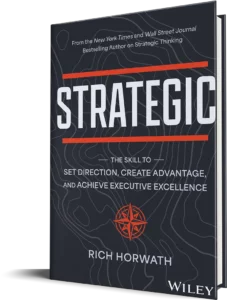In the flurry of end-of-year activity, it’s easy to glide right into the new year without pausing to reflect on the past year and set strategy for the new one and beyond. There are a number of factors you can use to assess this past year. When she sat down with her executive team to review their performances, Ginni Rometty, former CEO of IBM, used the following three questions:
- What lessons did you learn this year?
- How were those lessons learned? Were any learned from failure?
- What is your learning plan for the coming year?
These questions are instructive because they focus executives’ attention on insights. I define insights as “learnings that lead to new value.” This new value may come in the form of internal enhancements such as the elimination of manual reports or customer-facing benefits like one-step purchasing. Either way, it yanks managers off of the activity treadmill and into the reality of results.

Thinking Strategically With an Insight Network
In the past year, I’ve worked with a number of organizations on what I refer to as the “Insight Initiative” which has three components:
1.Awareness: educating managers at all levels on the importance of insights to the company’s future success and tools they can use to generate those insights.
2.Accountability: making each leader accountable for harvesting 3-5 insights from her team each quarter.
3.Action: creating a virtual insight network within the company so that new learnings are coalesced and shared on a regular basis, creating a true learning organization.
From a strategic perspective, look at the following three factors when assessing the fitness of a company’s strategy:
What is a Strategic Plan?
1.Strategic Direction. Research shows that employees are 40 percent more likely to commit to a leader when that leader demonstrates the ability to set clear strategic direction. Strategic direction means that a leader has involved their team in ongoing strategy conversations that have created their top 3-5 goals, the objectives to track them, and the strategies to deliver on them. The strategic direction is then reflected in a 1-2 page blueprint for the business that is actively communicated and modified by each leader for their respective team.
A tool called the StrategyPrint serves this purpose. Page one of the StrategyPrint acts as a real-time repository for strategic insights on the market, customers, competitors and the company. Page two of the StrategyPrint houses the team’s strategic action plan—how they will transform the key business insights into the success parameters that they’ve established. Running a business without a 1-2 page strategic action plan that guides the daily activities of all team members is like driving a car on a winding mountain road at night with the headlights off—exciting and adrenaline-filled right up to the point where it plunges off the cliff and crashes. Does your team have crystal clear strategic direction for the new year or are the headlights off?
How Do I Create Competitive Advantage?
2.Competitive Advantage. A study by Harvard Business School found that companies with clearly defined and well-articulated strategies outperformed their competitors by 304 percent in profit margin and 332 percent in sales over a ten-year period. Competitive advantage can be defined as the ability to deliver superior value based on differentiation in capabilities and activities. One of the most productive exercises in the strategy workshops I lead with executive leadership teams is called the “Competitor’s Strategic Approach.” It’s where we move beyond the superficial assessment of a competitor’s products, features, and benefits and take a more granular view of seven key areas, including capabilities.
Capabilities consist of a group’s resources and the activities they use to employ them to their advantage. Examples of capabilities include Marvel Comics’ repurposing of content and Nerf’s product development. One of the keys to establishing competitive advantage in a market is understanding how your capabilities stack up versus the competition, and which levers to pull to change the dynamic if necessary. Does your business have competitive advantage or are you bobbing up and down in a sea of mediocrity and commodity status?
How Do I Build Innovation into My Strategy?
3.Profitable Growth. When it comes to assessing the success of running a business, perhaps the following says it best: “The jury is at the bank down in the vault.” In most cases, losing money is a result of one of two causes: 1) short-term investment for a longer-term gain; or 2) bad/non-existent strategy. Research supports the latter. A 25-year study of 750 bankrupt companies found that the #1 cause of bankruptcy—80 percent of the time—was bad strategy. If a business lost money this year, it can blame the economy, politics, climate change or competitive headwinds. But, more than likely, its’ strategy was weak.
A number of exercises I lead during strategy workshops involve the methodical discovery of new pockets of value in a company’s customer landscape. One of the most fruitful exercises is the Value Mining Matrix, where we take a deep dive into customers and their current and emerging needs to tap into new pockets of innovation. Observing the challenges and struggles customers are experiencing is often a clear path to identifying ways to create new value.
As you move into the new year, one of the most powerful questions you can reflect on is, “What will we do differently this year?” Doing the same things in the same ways and expecting different results is Einstein’s definition of insanity. Remember, new growth comes from new thinking. Is your team prepared to think differently in the new year?
Learn more and order your copy of STRATEGIC: The Skill to Set Direction, Create Advantage, and Achieve Executive Excellence today at www.Strategic-Book.com

